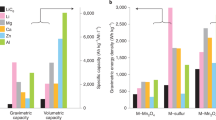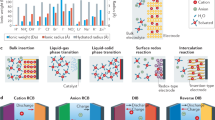Abstract
SECONDARY batteries normally store energy by accumulation of electrode products formed by electron transfer, that is, production of a reducing agent at one electrode and an oxidising agent at the other electrode. I have demonstrated a storage battery concept that depends on the energy associated with ionisation of slightly dissociated compounds, for example, forcing the equilibrium H2O⇌H++OH− to the right stores energy. A cell for recovery of this energy as electricity is described here. De Körösy and Zeigersen have mentioned the possibility of a primary battery based on these principles1.
This is a preview of subscription content, access via your institution
Access options
Subscribe to this journal
Receive 51 print issues and online access
$199.00 per year
only $3.90 per issue
Buy this article
- Purchase on Springer Link
- Instant access to full article PDF
Prices may be subject to local taxes which are calculated during checkout
Similar content being viewed by others
References
De Körösy, F. & Zeigersen, E. Israel J. Chem. 9, 483–497 (1971).
Frilette, V. J. J. Phys. Chem. 60, 435–439 (1956).
Benjamin, B. thesis Columbia Univ. (1976).
Nagasubramaniun, K., Chlanda, F. P. & Liu, Kang-Jen, J. Membrane Sci. 2, 109–124 (1977).
Serfass, E. J. US Pat. 3,488,035, June 3, 1969.
Renaud, M. Can. J. Chem. 47, 4702–4704 (1969).
Author information
Authors and Affiliations
Rights and permissions
About this article
Cite this article
RAMP, F. Secondary batteries powered by forced ionisation. Nature 278, 335–337 (1979). https://doi.org/10.1038/278335a0
Received:
Accepted:
Published:
Issue Date:
DOI: https://doi.org/10.1038/278335a0
Comments
By submitting a comment you agree to abide by our Terms and Community Guidelines. If you find something abusive or that does not comply with our terms or guidelines please flag it as inappropriate.



